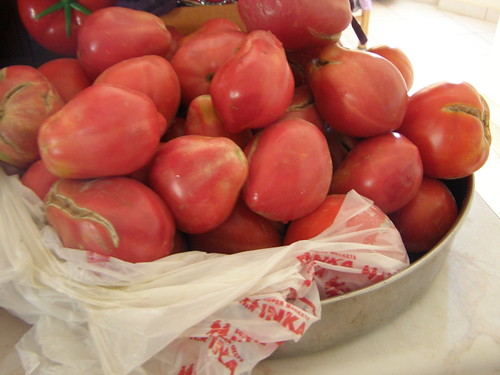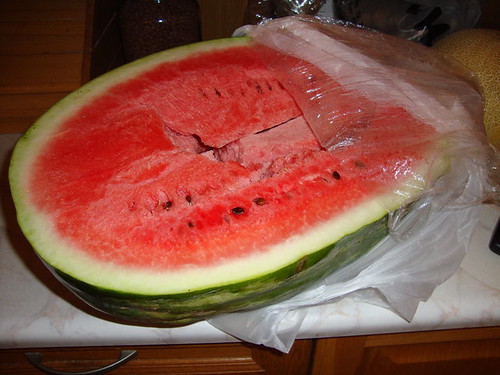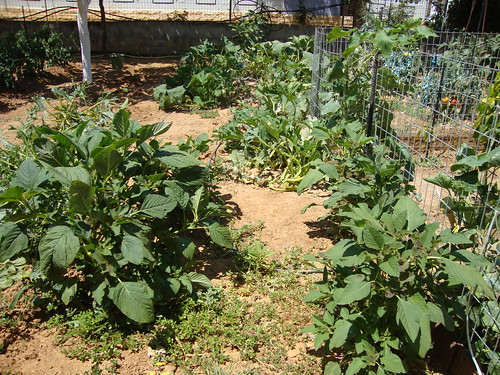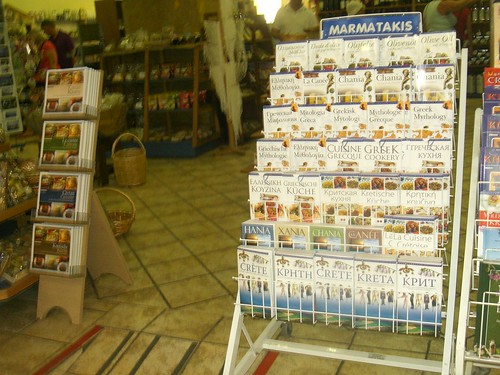LOCAL will sell you only Cretan tomatoes; even when we limit ourselves to localness, there is still a wide range to choose from: large beef tomatoes, small soft cooking tomatoes, vine tomatoes, and son on. Why should LOCAL bother bringing anything else in the first place? They may be tasteless in the winter (because they are grown in greenhouses), they may be odd shapes and sizes year-round, sometimes they will be soft, but they will rarely be too firm or under-ripe. You even have a choice cost-wise: B' grade tomatoes are cheaper.
This is a local variety of tomato; it isn't marketed even though may people grow it all over Hania. It cracks easily, the top stays green, and it has an odd shape.
NATIONAL, on the other hand, will sell you the most beautiful looking tomatoes you will ever see in your life. They may not have been grown in Crete, but they will all have a uniform shape, they will never look 'off', their skin will be perfectly red, they won't have a blemish on them. having said all this, they will also be tasteless, because that's what most multi-national competitive upmarket-supermarket tailor-grown produce is like: beautiful to the eye, distasteful to the tongue. Beauty has always been skin deep.
The perfect tomato, or is it? NATIONAL supermarket tomatoes
This gypsy truck was parked by my local beach for a while, on the pretext of selling watermelons.
You could argue yourself black and blue trying to convince them that you really do want to buy that super-size watermelon but you just can't carry one whole big watermelon in one hand (it usually weighs 10-15 kilos), and it would be a great help if the seller would be so kind as to cut it into two pieces and put it in two bags so that you can share the load. They simply cannot see the logic in this, especially when they know they are selling unripe and/or tasteless watermelons when (the flesh is very light pink, and it tastes almost like a sweet cucumber). If you're buying a big one (which is more likely to be ripe), you feel let down when, upon opening it, you realise that it is a bad 'un, not to mention the fact that you have just wasted your money (this used to happen to us every season until this year).
Since you get what you pay for, it's always more preferable for the transaction to be as transparent as possible.
Because NATIONAL is opening up those watermelons and therefore providing more transparency in the food chain), allowing consumers to try-before-they-buy, LOCAL will follow suit in no time, as I recently discovered. But NATIONAL is still one step ahead of them, because they have already cut the watermelons, whereas LOCAL still expects you to choose the watermelon of your choice and then cut it - which means that you still run the risk of choosing a bad 'un, and getting involved in a fracas with the seller.
*** *** ***
Well, you can guess which supermarket is selling the well-known (at least to most of the modern world) pre-cut, no-washing-required, pre-packed, ready-to-eat (at least, that is what it says on the packet) salads in a plastic bag to the Cretans, can't you? Pre-cut bagged salads are, generally speaking, a relatively new way of selling fresh produce. Oh, it's for the foreigners, you say, the tourists and the trickles of ex-pat Europeans who have come to start a new life in their retirement among the Greek gods. Not so, from what I discovered just recently.
I was waiting to get some beetroot weighed at the fresh produce counter. Waiting is unusual in high-end supermarkets or multi-national chains - they even over-do the 'Hello', 'Good morning', 'Thank you' and 'Have a nice day' formalities, which is very not Greek (in the LOCAL, you get: "Γεια σου κοπέλα μου!" and you can exchange a dirty joke or two if you know the assistant well enough). While I waited, never wanting to waste a minute (and that's a loooooooong waiting time in a supermarket of high calibre, isn't it), I got a pen out of my bag and noted down the prices of those bagged fresh salads on my shopping list. And what a range to choose from! There was:
- σαλάτα εποχής (seasonal salad): 130g/1.50 euro, consisting of shredded/torn lettuce, rocket and other greens, none of which actually have a specific season per se
- σαλάτα κηπουρού (gardener's salad): 230g/1.74 euro consisting of shredded/torn lettuce leaves and some other cheap leafy greens (eg parsley)
- σαλάτα καπριτζιόζα (capricciosa salad): 160g/1.81 euro consisting of shredded/torn lettuce varieties that are curly (hence the raunchy name ascribed to it)
- σαλάτα τρίχρωμη (tri-coloured salad): 160g/1.81 euro consisting of shredded/torn lettuce varieties in different colours (eg pink or purple leaves)
- σαλάτα φάρμα (farm salad): consisting of of shredded/torn lettuce leaves mixed with cabbage and carrot
He gave me that knowing look (= "wtf is she doing?")**, which I understood immediately (= "I have nothing to hide"), so I gave him my routine explanation, which I spew on pretty much anyone who can't for the life of them think why I would want to take notes while on a routine shopping expedition when they ask me what I'm doing, and in Hania, which goes something like this:
"I'm just doing a price comparison,"
or
"This looks like a new product, and I'm making a note for future reference,"
or
"I'm just wondering who would buy this sort of crap, I mean, thing."
It was the last one that concerned me on this particular day: who is likely to buy pre-cut non-local over-priced mainly-cheap-lettuce salad in a place like Hania, where fresh produce grows under the Mediterranean sun, and it borders aromatic plants, all of which give our crops that special 'Taste Crete' gout. This bag of shredded greens was clearly not from Crete: in fact, if you looked at the packaging (like I did), you would be amazed to discover that not only was this chlorine-washed ready-to-eat 'fresh salad' not from Crete, but it contained products that weren't even grown in Greece. NATIONAL even ships edible weeds (purslane) and common varieties of horta (like vlita) which have been grown in the Attiki region (to which Athens belongs) to their stores in Crete, at the same time that we are completely deluged by the stuff overtaking the garden and growing without any assistance.
Click the notes to seethe free food we get from our garden; in Crete, you don't need to spend you rprecious euros buying this stuff - just ask someone nicely of they could pull out a few weeds for you from their patch of earth.
Concerning the bagged salads, Mr Fresh-Produce told me that lots of people buy it, not just tourists - in his own words:
"We don't have tourists in the winter, so who are we stocking it for then, and why are they buying it?"
Actually, I didn't really need to ask Mr Fresh-Produce who would eat this stuff in Crete, since I already know of people who regularly buy it:
"I love salads," a friend once said to me, "but I hate all that cleaning and chopping; it's so much easier to buy a bag of chopped salad."
My MD also confirmed what I (and most people) have suspected all along: he said his patients generally do not follow the Cretan diet any longer, which is why the incidence of heart disease has risen alarmingly in Crete. It isn't my own MD who is talking about this same problem: in a public speech concerning the Cretan diet (organised in Hania by ILAEK), another MD in Hania made reference to the rapid rise in consumption of the ready-to-eat foods consumed by young couples (he pointed out this particular group): Gone are the days when women went to the fields 'για να βροβολογούν', gone are the days when the woman of the house 'έπλαθε, κοσκίνιζε και ύφαινε'. In addition, a few months ago, a Greek national newspaper published findings that revealed changes in the daily diet of young Cretans - the title of the article was: "Goodbye dakos, hello hamburger.".
The subject of the diet of the ancient and modern Greeks was discussed in a series of speeches made at the Municipal Garden open-air cinema in Hania recently. One of the speakers was History of Greek Food.
If anything has changed in the diet of the geographically isolated island, it has happened in the last 5-6 decades. Whereas Cretans once lived off whatever the earth gave them, supplementing this with bread and pulses (also known as 'poor man's meat'), and literally preserving or practically bathing all their food in olive oil, the modern Cretan now consumes fewer beans (they just aren't fashionable enough these days) and less bread (most young Cretan women have heard about the Atkins diet, even though they don't know who Dr Atkins is), while less olive oil now being used per capita on the island, despite Greece still having one of the highest per capita worldwide consumption rates for olive oil. Nevertheless, in places of 'mass congregation' (eg tavernas, fast-food restaurants, etc), more and more seed oils are being used (they're cheaper, and usually imported). There is no doubt about it: Cretans are eating a lot more animal fat, more lipids, more meat and more prepared food in their daily diet than they did 5-6 decades ago, and to the detriment of cereals, grains and bread - as well as to the detriment of their general health. Only a few days ago, the TV news was reporting the alarmingly increasing rates of high cholesterol levels of Greek children, attributed to a sedentary lifestyle and a poor diet. It's hard to believe that the diet of young Cretan children can be so bad, yet it is: Cretan children are said to be some of the fatter Greek kids around...
This photo was taken two years ago at an inter-school sports event in Hania. It gives you an idea what people look like here(kind of unhealthy, much heavier than they ever were in the past).
What looks like an imported food trend that may be favoured by the non-local population is actually being sold to locals, and being used to replace other products in the traditional diet. The temptation of buying a fuss-free product is immense in this day and age when both men and women are working away from the home for long periods of time: a ready-to-eat salad requires no cleaning up and it doesn't spoil your manicure.
The Cretan diet: a way of life or a marketable souvenir product?
As Cretans become more upwardly mobile, their food will have a more global appearance.


Yiayia Maria (early 70s) and Yiayia Calliope (early 90s); they both had five children each and both died nonagenarians. Maria was widowed during the Battle of Crete, while Calliope had the misfortune to outlive one of her children (my mother).
But I still can't help thinking about Michael Pollan's rules for eating, one of which states: "Don't eat anything your great-grandmother wouldn't recognize as food." Most of the salads contained lettuce varieties that would have been unknown to them in their time. Not even my grandmothers ever saw a bag of ready-to-eat salad in their life, but I wonder what they would have thought of it if they were presented with one, maybe something like:
"Μπα, πράμα δε κάνει. Σα' τ'αχυρά 'ναι.Δε'ν'αυτό φαγητό, παιδί μου, βάλ' το στο κουβά για τσ' όρνιθες, μπας και το φαν' αυτές."
(Ba, prama de ganei. Sa t'ahira 'ne. De 'nafto fajito, val' to sto gouva gia ts'ornithes, bas ke to fan aftes.)
Nah, it's useless. Like eating straw. Put it in the bucket for the chickens (ie where the leftover vegetable scraps are placed, used as animal feed), they might eat it.
*** *** ***
για να βροβολογούν = foraging, picking wild greens
έπλαθε, κοσκίνιζε και ύφαινε = shaped (bread), sifted (flour) and wove (cloth)
*Most supermarkets around Greece are based on this kind of scenario: one or two local and a few national chains.**I don't really know if, in Hania, it is still unusual for consumers to pay more attention than a cursory look at the label, and maybe a glance at the fineprint of the packaging, or whether it's just me and the effect I have on people that makes them suspicious of my eager-beaver interest in what I'm buying to feed my family...
©All Rights Reserved/Organically cooked. No part of this blog may be reproduced and/or copied by any means without prior consent from Maria Verivaki.









The trends you describe are the same trends we have here. Mixed lettuces and mesclun are bought in cello packs. Packaged lettuces were related to an e-coli outbreak so convenience is not always the way to go for many reasons. A local Okanagan producer sells their mixed letttuces in a cello pack for $5.99 or we could buy it for $1.99 a head...it is obvious that concenience comes at a price but the producer makes a larger profit.
ReplyDeleteΑυτές τις σαλάτες τις έχω δει κι εδώ σε ένα national super market. Δυστυχως, ο τρόπος ζωής έχει αλλάξει από παλιά. Οι γυναίκες δουλεύουν, μια γυναίκα είναι μάνα, σύζυγος, εργαζόμενη συχνά για πάρα πολλές ώρες. Η έλλειψη χρόνου, η κούραση, η επιθυμία να ξεκουραστείς ή να μην κουραστείς ΚΑΙ στο σπίτι, οδηγούν σε ένα τρόπο διατροφής κοντά σε ξένα πρότυπα, μακριά από τη μεσογειακή διατροφή, που φυσικά πληρώνεται στην υγεία μας. Αν αυτό συμβαίνει πια και στην Κρήτη, τα πράγματα δεν είναι καλα. Πιστεύω ότι ο άνθρωπος θέλει να γυρίσει στις παλιές συνήθειες, εκτιμά το χειροποίητο, αλλά ο σύγχρονος τρόπος ζωής τον εμποδίζει. Και χαιρομαι που βλέπω ανθρώπους να ξαναζυμώνουν ή να κόβουν φρέσκια σαλάτα και ας παιδεύονται παραπάνω. Μακάρι να γυρίσουμε στα δικά μας πρότυπα, γιατί είναι κρίμα...
ReplyDeleteI never had any kind of lettuce when I visited Crete. Can't say I missed it. I did have horta though which I loved. There was a recent TV programme in England about two overweight young people going to stay with an even more overweight Cretan family - husband, wife and young daughter - to see what they could learn about diet. It was on BBC3. Think it was called Large meets Larger or something like that. It is part of a series. I had no idea until then that there was a problem with diet there.
ReplyDeleteI really enjoyed reading your post Maria even though it saddens me. I always thought that especially the Cretans are so proud of their produce that they wouldn't willingly choose to eat prepackaged stuff, not home grown.
ReplyDeleteI keep reading about food movements in other countries where people try to go back to eating local produce not only because it is healthier but because they want to support their local economy. That is another important factor I think in this whole mess.
Magda
Maria,
ReplyDeleteAfter reading this article, all I can think is...I have to meet you!! I don't know ANYONE besides myself who (1) takes (sometimes copious) notes in a grocery store or market, or who (2) has their stash of one-liners ready for response. Loved your article, couldn't agree more about EVERYTHING, and really hope to meet you one day.
Thanks for all your wonderful posts and contributions. I have been reading your blot for many months now and enjoy it tremendously.
Filia apo tin Athina, Demetra